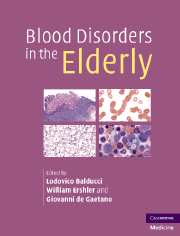Book contents
- Frontmatter
- Contents
- List of contributors
- Preface
- Part I Epidemiology
- Part II Hematopoiesis
- Part III Anemia of aging
- Part IV Hematologic malignancies and aging
- 18 Cancer chemotherapy in the older person
- 19 Acute myeloid leukemia in the elderly
- 20 Acute lymphoblastic leukemia in the elderly patient: diagnosis and therapy
- 21 Multiple myeloma
- 22 Non-Hodgkin lymphoma
- 23 Unusual lymphomas in the elderly
- 24 Chronic lymphocytic leukemia in the elderly
- 25 Polycythemia vera and idiopathic myelofibrosis in the elderly
- Part V Disorders of hemostasis in the elderly
- Index
25 - Polycythemia vera and idiopathic myelofibrosis in the elderly
from Part IV - Hematologic malignancies and aging
Published online by Cambridge University Press: 21 October 2009
- Frontmatter
- Contents
- List of contributors
- Preface
- Part I Epidemiology
- Part II Hematopoiesis
- Part III Anemia of aging
- Part IV Hematologic malignancies and aging
- 18 Cancer chemotherapy in the older person
- 19 Acute myeloid leukemia in the elderly
- 20 Acute lymphoblastic leukemia in the elderly patient: diagnosis and therapy
- 21 Multiple myeloma
- 22 Non-Hodgkin lymphoma
- 23 Unusual lymphomas in the elderly
- 24 Chronic lymphocytic leukemia in the elderly
- 25 Polycythemia vera and idiopathic myelofibrosis in the elderly
- Part V Disorders of hemostasis in the elderly
- Index
Summary
Introduction
The chronic myeloproliferative disorders, polycythemia vera (PV), idiopathic myelofibrosis (IMF) and essential thrombocytosis (ET), are acquired clonal stem-cell disorders involving a multipotent hematopoietic progenitor cell, and are characterized by overproduction of one or more of the formed elements of the blood, a tendency to develop extramedullary hematopoiesis, and, in a small percentage of patients, transformation to acute leukemia. Although uncommon, these disorders are not rare, and recent scientific advances have shed new light on their pathogenesis. The current World Health Organization (WHO) classification scheme for the chronic myeloproliferative diseases places PV, IMF, and ET in the same category as chronic myelogenous leukemia (CML), chronic neutrophilic leukemia (CNL), chronic eosinophilic leukemia (CEL), and the hypereosinophilic syndrome. However, this classification scheme ignores that fact that other than bone-marrow hyperactivity, PV, IMF, and ET are totally different from CML, CNL, and CEL with respect to clinical course and molecular pathogenesis, but closely related to each other. Indeed, PV, IMF, and ET have occurred in different members of the same family and their clinical and molecular features are sufficiently similar (Table 25.1) that, rather than being separate disorders, they could well be different manifestations of the same disorder. Moreover, given the body's limited biologic repertoire, both possibilities are likely.
- Type
- Chapter
- Information
- Blood Disorders in the Elderly , pp. 370 - 384Publisher: Cambridge University PressPrint publication year: 2007



